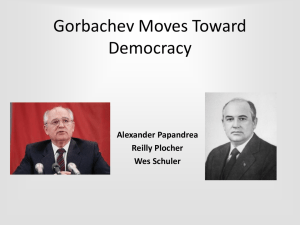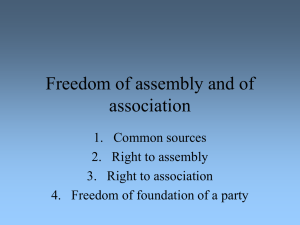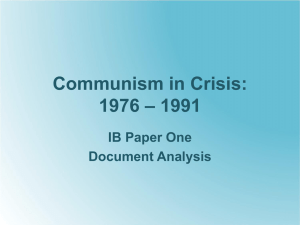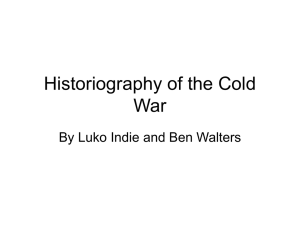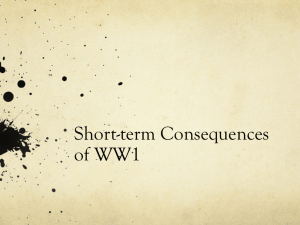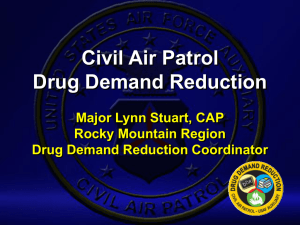Revolutions of 1989 POLAND
advertisement
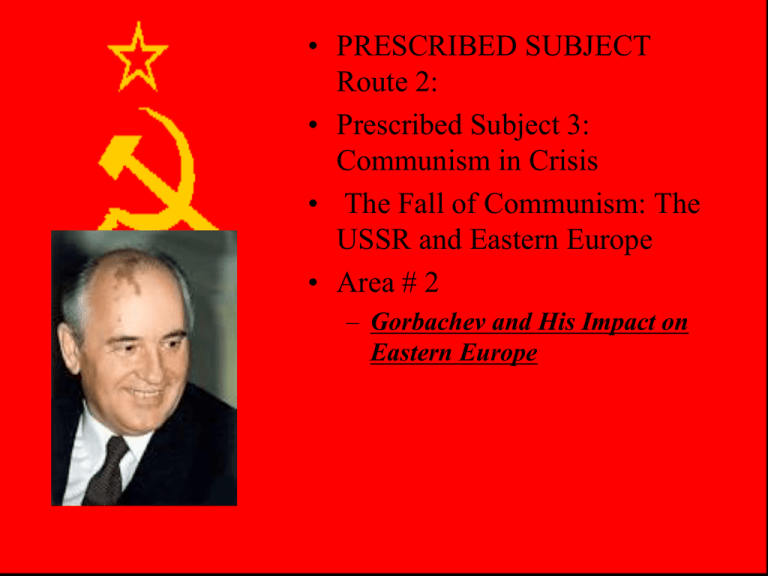
• PRESCRIBED SUBJECT Route 2: • Prescribed Subject 3: Communism in Crisis • The Fall of Communism: The USSR and Eastern Europe • Area # 2 – Gorbachev and His Impact on Eastern Europe Revolutions of 1989 • Gorbachev’s Policies do have major impact, however… – Long history of oppostion in E. Europe – E. Berlin revolt 1953, Hungary 1956, Czech 1968 • Causes – Economic backwardness in E. Eur. • Lag behind West do to lack of innovation • Becomes worse as high tech explosion emerges 1970’s- ‘80s – East bloc gov’ts are Soviet puppets imposed on the states they govern by the USSR • No legitimacy • No elections • Several Soviet invasions – Repressive gov’ts • Secret Police systems in all E. Bloc states – E. Ger. STASI has files on 1/3 of population (smell jars for blood hounds) • Polish Army crackdowns 1970, ‘76, ‘81, Martial Law 1981-83 • Why the collapse in 1989 Revolutions of 1989 – Economies worsen in 1980’s • Huge debts in Poland (40 bi.), Czech (4 bi.), DDR (7.6 bi.) – Ruling Communists split over reforms • Some try to be more inclusive but fail to get cooperation – Gorbachev reforms encourage mimicry and opposition groups – Gorbachev says socialism can vary state to state – Gorbachev won’t intervene in E. Eur. Militarily – Gorbachev spokesman says Brezhnev Doctrine no longer in place • Initially Gorbachev is not believed (Khrushchev example) • East Bloc is too costly to maintain • Doesn’t want to damage links to the West – Gorbachev doesn’t realize it will be so fast or complete • Assumes reforms will occur but not overthrow of regimes – Media Impact (can’t keep events secret anymore) • TV, Radio create multiplier effect (Jamming ends with Détente • Why won’t Gorbachev Intervene? Revolutions of 1989 POLAND – Buffer zones useless with Nuclear weapons so East Bloc no longer justified – East Bloc is huge financial drain (Warsaw Pact, Stationing Troops, aid to debtors like Poles) – Fears he will look like a fool if he cracks down in East Bloc while reforms at home • POLAND – Solidarity Role is key – 1980-81 huge strikes • • • • Martial law declared 1981 and Solidarity Union is Banned Gov’t trie to reform when Martial law ends 1983 Hopes to split opposition with moderate reforms Need to raise prices due to debt, but fear riots (1970, 1976, 1980-81 due to price increases) • Negotiate with Catholic Church – Fails due to Murder of Father Popieluszko a reformer – Pope JP II visits and supports Solidarity • 1983 Solidarity is weakened Revolutions of 1989 POLAND – One leader Michnik wants 30% of Assembly seats freely elected – Gov’t negotiates but can’t wait on reform of prices – Other Solidarity leaders oppose Michnik – No progree til 1986 and debt increase 35% – 1986 demand amnesty for arrested Solidarity (SD) members – Jaruzelski can’t wait and holds referendum on econ. and political reforms 1987 “Referendum on Reform” • Backfires, SD boycotts vote and can’t get 50% to pass it – Jaruzelski goes ahead anyway raises prices 40-50% • More increase to follow • Strikes in May and August and SD steps in, negotiates end to strikes and shows its power with workers – Analysts “The Group of Three” offer new reforms in 1988 and Jaruzelski accepts their report • Proposal is an elected Senate and Parliament in which 40% of the seats would be freely elected • Takes five months to open negotiations • Revolutions of 1989 POLAND “The Group of Three” (con’t) – Delay caused by threat of Communist hardliner coup and Solidarity demans that union be made legal – Jaruzelski has to threaten to resign to get hardliners to accept talks – “Round Table” Talks finally approved Jan. 1989 • Communist goal is reform w/o loss of Party control • SD represented by T. Mazowiecki, B. Geremek, W. Trzeciakowski • April Accords are the result – Free Senate Elections – 35% of Parliament freely elected – Office of President to be elected by Senate and Parliament – The June Elections • Gov’t overestimates its support in free elections • First round SD gaets 92 of 100 open senate seats and 160 of 161 Parliament open seats • Second round they get 99 senate and all parliament seats • Revolutions of 1989 POLAND Jaruzelski elected President – cautious SD members fear a Soviet invasion or Hard liner coup if he is ousted • Aug. to Sept. 1989 – More aggressive SD like Michnik now demand an SD Prime Minister (“Your President our PM” formula) – Jaruzelski offers cabinet posts only but caves in a month – Mazowiecki (SD) made PM – Reason is communist allies United Peasants and Democrats shift to SD side – Lech Walesa the founder of SD brokers the deal with the other parties • Doesn’t fear a coup as communists are weak – Walesa elected resident Dec. 1990 and replaces Jaruzlski – Economic problems remain but European Union gives aid to new democracy • Hungarian revolution bloodlesslike Poland Revolutions of 1989 Hungary – Had actually begun reforms before Poles – Private Enterprise like NEP permitted in early 1980’s – Also have Multi-candidate elections since 1985 (candidate does have to be approved by the gov’t) • Revolution begins due to Communist Party infighting – Janos Kadar (Pres.) appoints Karoly Grosz as PM – Grosz is aided by reformer Imre Posgay and ousts Kadar – Grosz and Posgay argue • Posgay wants to end Party’s lead role and acknowledge 1956 Soviet invasion as a crime • Eventually rehabilitate Imre Nagy who was arrested and executed by Soviets in 1956 – National Round Table talks modeled on Poland • • • • Multi-party elections Mach 1990 communists get only 10% Democratic Forum and Alliance of Free Democrats win No open borders which helps bring on East German collapse E. Ger. Can enter Hungary, cross to Austria the enter West Germany Revolutions of 1989: East Germany (GDR/DDR) • East Germany (DDR/GDR) is most prosperous East Bloc state – Debt however is 27 bi. in 1989 – Party Leader Eric Honecker is tough and willing to use force – Problem is USSR reforms and Poland and Hungary revolutions undermine DDR – TV and Radio from West Germany (FRG) can be seen in DDR – 1989 500,000 flee through Hungary – Protests in Berlin and Leipzeig causes Honecker to close DDR borders – SED (Communists) feel reforms are their only hope – Gorbachev now visits • Won’t support violence • Implies Honecker ought to be fired and he is forced out • Egon Krenz new leader Revolutions of 1989: East Germany (GDR/DDR) • Krenz wants Gorbachev style reforms – Promises free travel ‘in the future” – Spokesman incorrectly gives impression free travel begins immediately – 100’s of 1000’s arrive at Berlin Wall and outnumbered border guards stand aside – Start to knock it down (catalyst for rapid change) – Mar. 1990 censorship ends – SED now investigated for corruption and news coverage forces whole Politburo to resign Dec. 1990 – Gysi the new leader negotiates multiparty elections March 1990 • Collapse is rapid 200,000 leave in two months • Reunification (NOT ON EXAM) – FRG PM Kohl offers currency union and visits 6 times – March Elections Center-Right (favor immediate unification wins) 48% SPD 25% SED only 16% Revolutions of 1989: East Germany (GDR/DDR) • Reunification (NOT ON EXAM) (con’t) – Gorbachev stunned as 300,000 Soviet troops in DDR – Proposes neutral reunified Germany (leave NATO) – Backs off and agrees to Ger. In NATO in no troops in Eastern Germany – 4 Powers give up authority in Germany – May 1990 currency unified – Sept. 4 Powers approve unity – Oct. Reunification – Dec Kohl wins 1st united Germany elections Revolutions of 1989: Czechoslovakia The Velvet Revolution • Czech Communist Leader Gustav Husak placed in charge by USSR 1968 – Replaced by Milos Jakes 1977 – Charter 77 a dissident group forms 1977 • • • • Vlacav Havel playwright is leader Demand Helsinki Accords rights Catalogue Husak’s abuses Many members key figures in 1989 revolt – Domino effect is in play • Party united seems secure • TV, Radio coverage destabilizes regime as other East Bloc states fall – Protests begin Nov. 1989 • Secret Police respond violently equals more protests • Civic Forum (CF) created with Havel as leader » Coordinates protests and persuades others to support the Party • General strike Nov. 27 and other groups like VPN join • Nov. 24 Dubcek released Revolutions of 1989: Czechoslovakia The Velvet Revolution • • • • New PM Adamec trys to negotiate short strike Shouted down Strike forces gov’t to introduce concession Propose 15 Communists 5 non-communists in the cabinet – Protests follow Adamec resigns • “Oblong Table” talks – Dubcek a communist Chairs Assembly – Havel is President – Elections June 1990 • • • • Multi-party Non-communists win Gorbachev takes troops out 1991 Slovakia leaves Jan 1993 ½ the size of Czech population

![The_End_of_the_Cold_War[1]](http://s2.studylib.net/store/data/005216723_1-d7985d2049f1fbeae49e8feeba5d6d3b-300x300.png)
